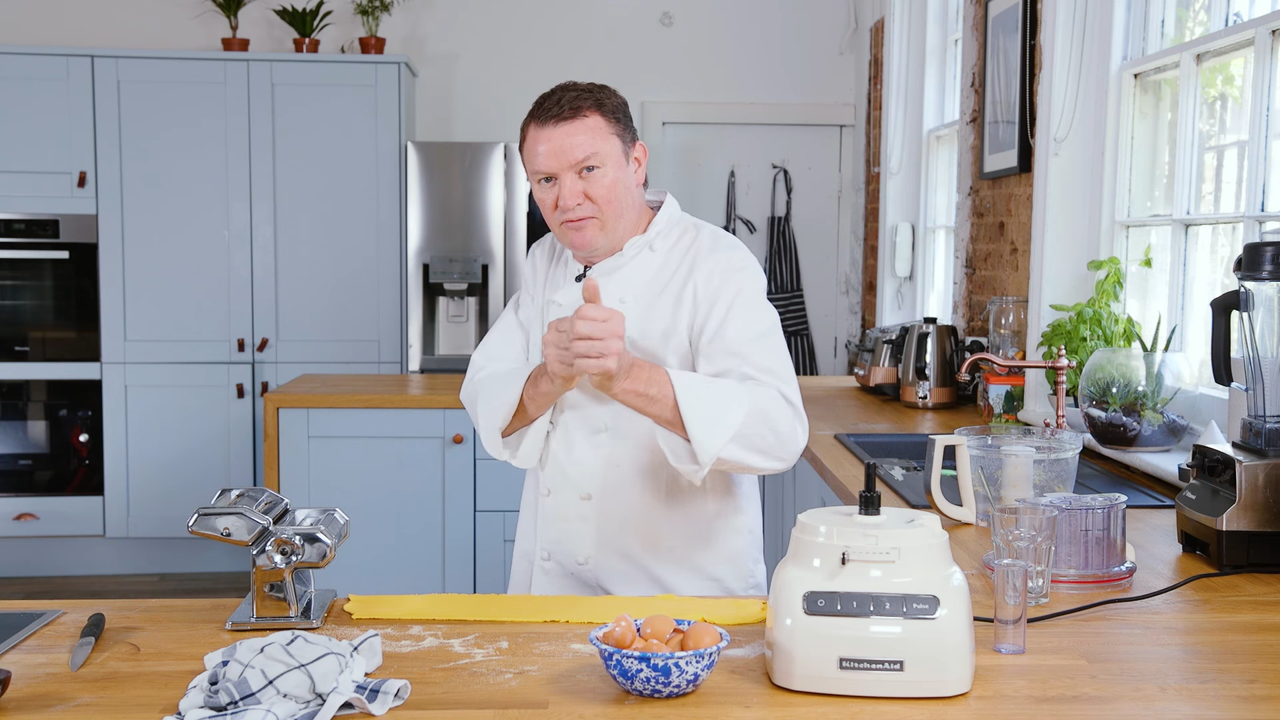
Theo Randall's homemade pasta recipe is the only base you need to rustle up a range of pasta types, including lasagne sheets, tagliatelle and farfalle.
With just three ingredients, you’d think that making pasta sounds simple enough, but it’s important not to skimp on quality. If the budget allows, go for recently-laid organic eggs with bold-coloured yolks so your pasta has a fresh taste and an attractive yellow hue.
Some chefs omit eggs and use a mix of flour and water (this is the kind of recipe you tend to find in delis and grocers because, without the egg, it is easier to preserve) but if you want to make pasta in true Italian fashion, follow Theo’s step-by-step guide.
When it comes to flour, plain will not do – Tipo '00' flour is a must. This is an extremely fine durum wheat flour that’s typically used to make pasta. Its structure works to form a dough that’s both pliable and smooth, yet durable. Some chefs will only use Tipo '00' flour, eggs and nothing else, while some use semolina flour, which results in a firmer, heartier pasta. Theo’s recipe uses both types of flour.
And while it’s not essential, it’s worth treating yourself to a pasta machine – it will make your life easier and the process quicker.
Preparation
Very little preparation is needed for this recipe, and while it caters for those with a pasta maker, if you scroll further down you’ll see that we have a section on how to make different types of pasta by hand. You will, however, need a deep saucepan in which to cook the pasta, and a clean, damp tea towel to hand – this is used throughout the recipe to prevent the pasta from drying out.
A quick tip – it’s better to let fresh pasta prove, covered, for 30 minutes at room temperature before rolling it out or putting it through a pasta maker. This proving time allows the gluten in the flour to relax, which will help the pasta maintain its shape and flexibility.
Expect to put pasta dough through the pasta maker a few times to achieve the desired thickness. Start on the widest setting, folding the pasta after each roll, and do this half a dozen times before narrowing the rollers notch by notch until you’ve achieved the desired result (don’t forget to lightly dust the pasta with flour every time it goes through the machine, to prevent sticking). The pasta should have an elasticity and silky texture to it and, if you’re rolling it thin, you should able to see the outline of your hand through it.
Watch Theo Randall make homemade fresh pasta
Ingredients
- 350g ‘00’ pasta flour
- 25g semolina flour, plus extra for dusting
- 2 whole eggs
- 4 egg yolks
Method
Step 1
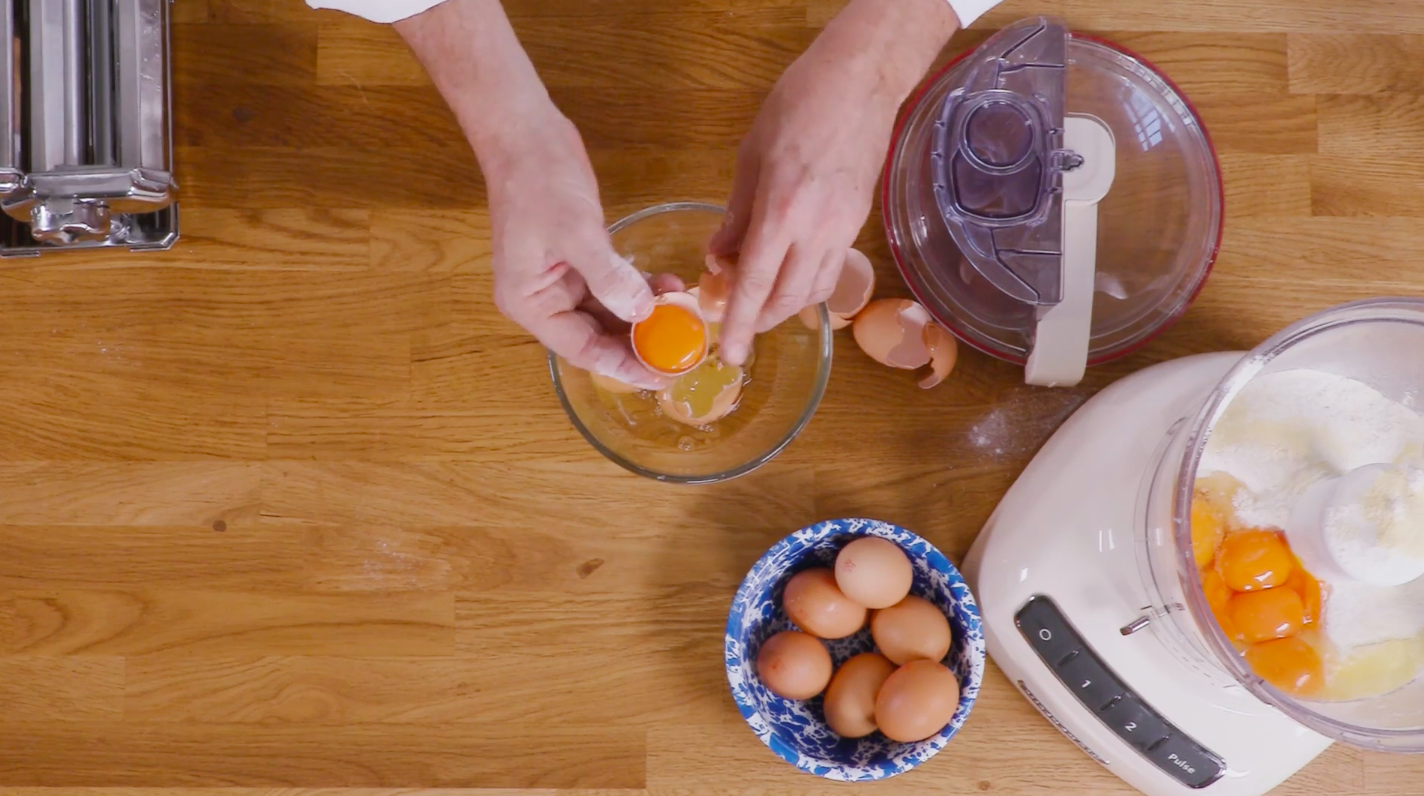
Mix all the ingredients, plus 1tsp water in a food processor and blitz until well formed. You don’t need to add any seasoning or oil.
If you don’t have a food processor you can do this by hand – make a mound from the flour and create a well in the centre. Add the eggs to the well. Slowly begin to bring the flour into the centre, gradually pulling it all in.
Step 2
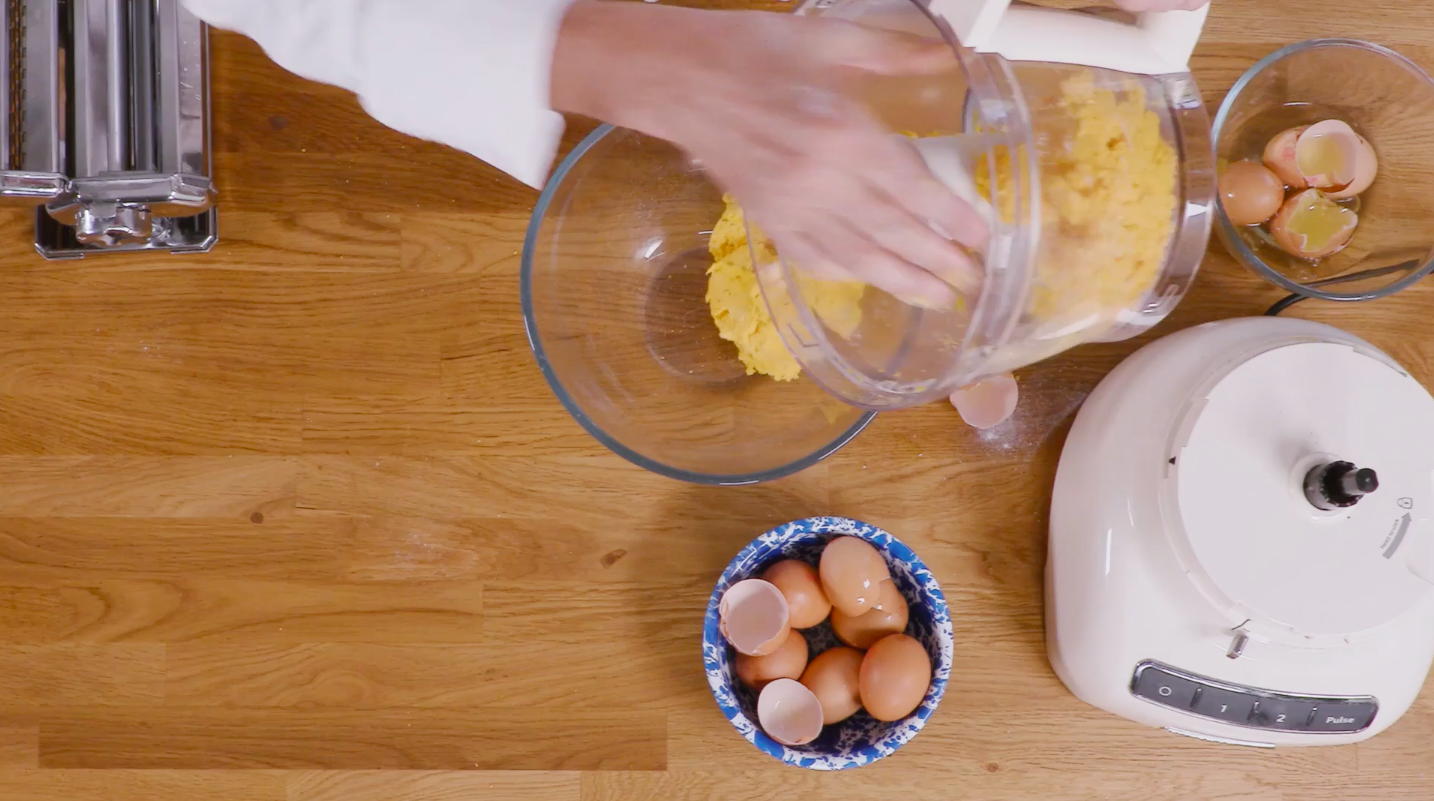
Once your dough has been brought together, by hand or in the food processor, check that it has the texture of Play-Doh – if it’s too dry, add a little more water.
Sprinkle semolina flour onto a clean, flat surface to prevent the dough from sticking and knead until smooth.
Step 3
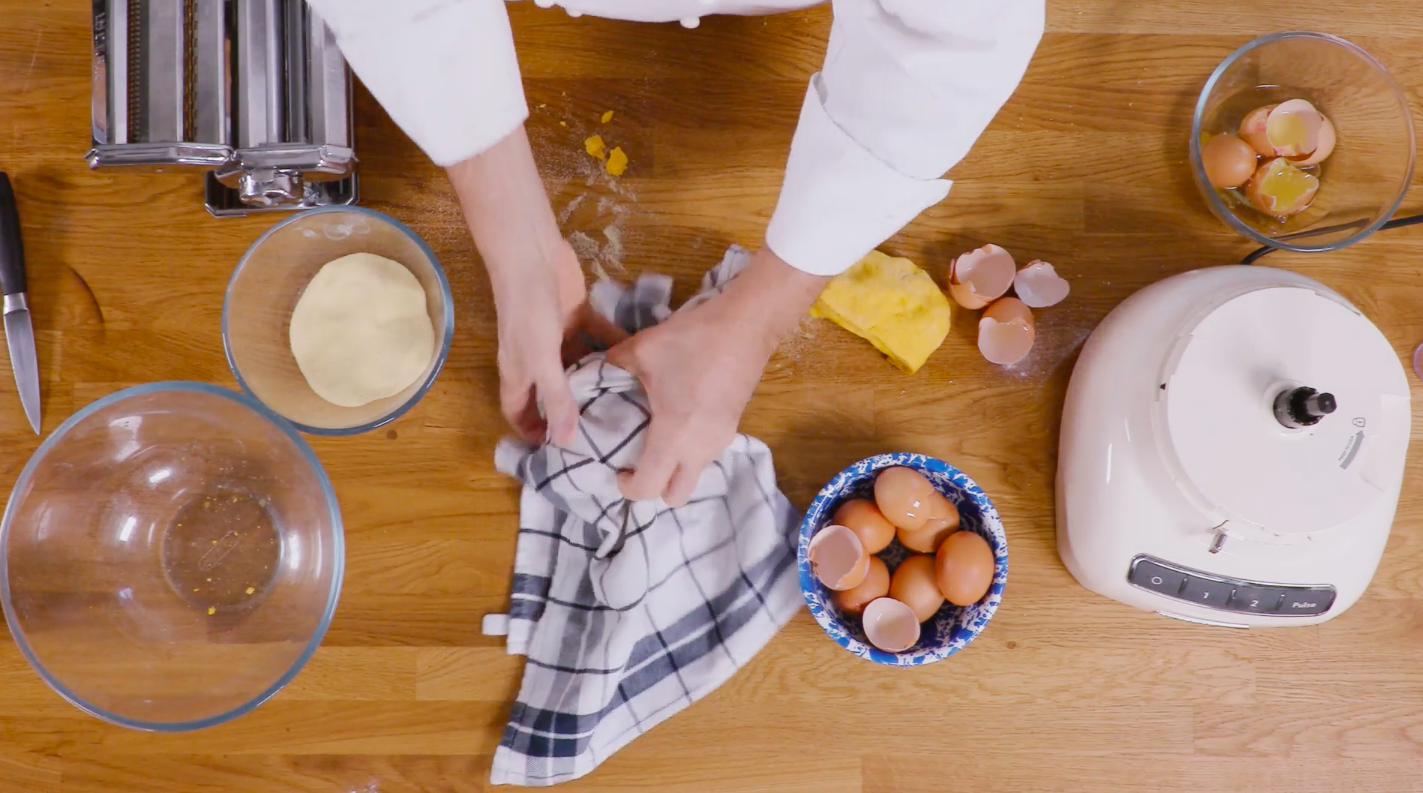
Cover with a damp towel and leave to rest for 20-30 minutes.
Step 4
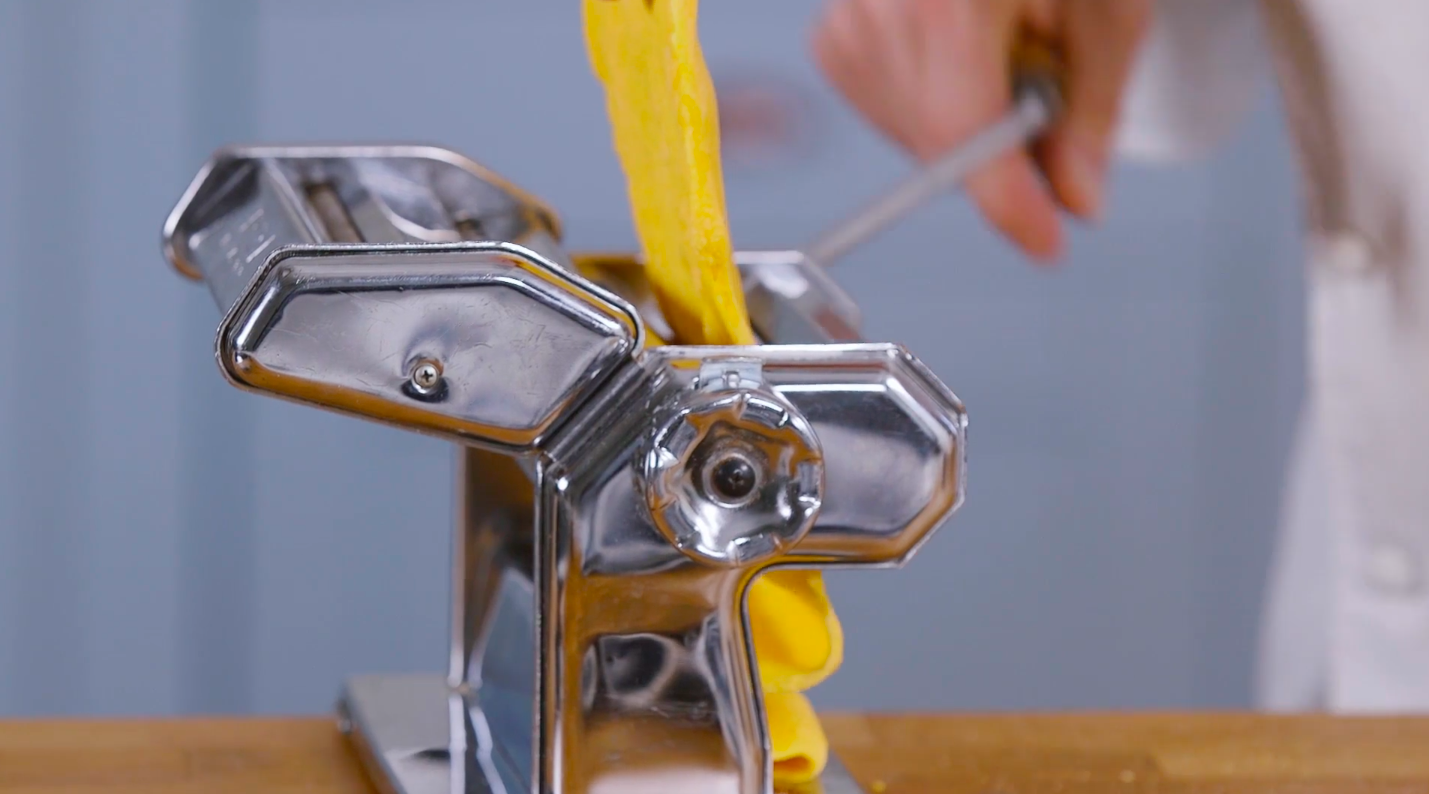
Divide the mixture into two, covering the ball you’re not working with. Flatten one ball of dough into a rough rectangle and slowly feed through the pasta machine on the widest setting, folding over each time. Repeat 5-6 times until the dough is smooth and elastic.
Step 5
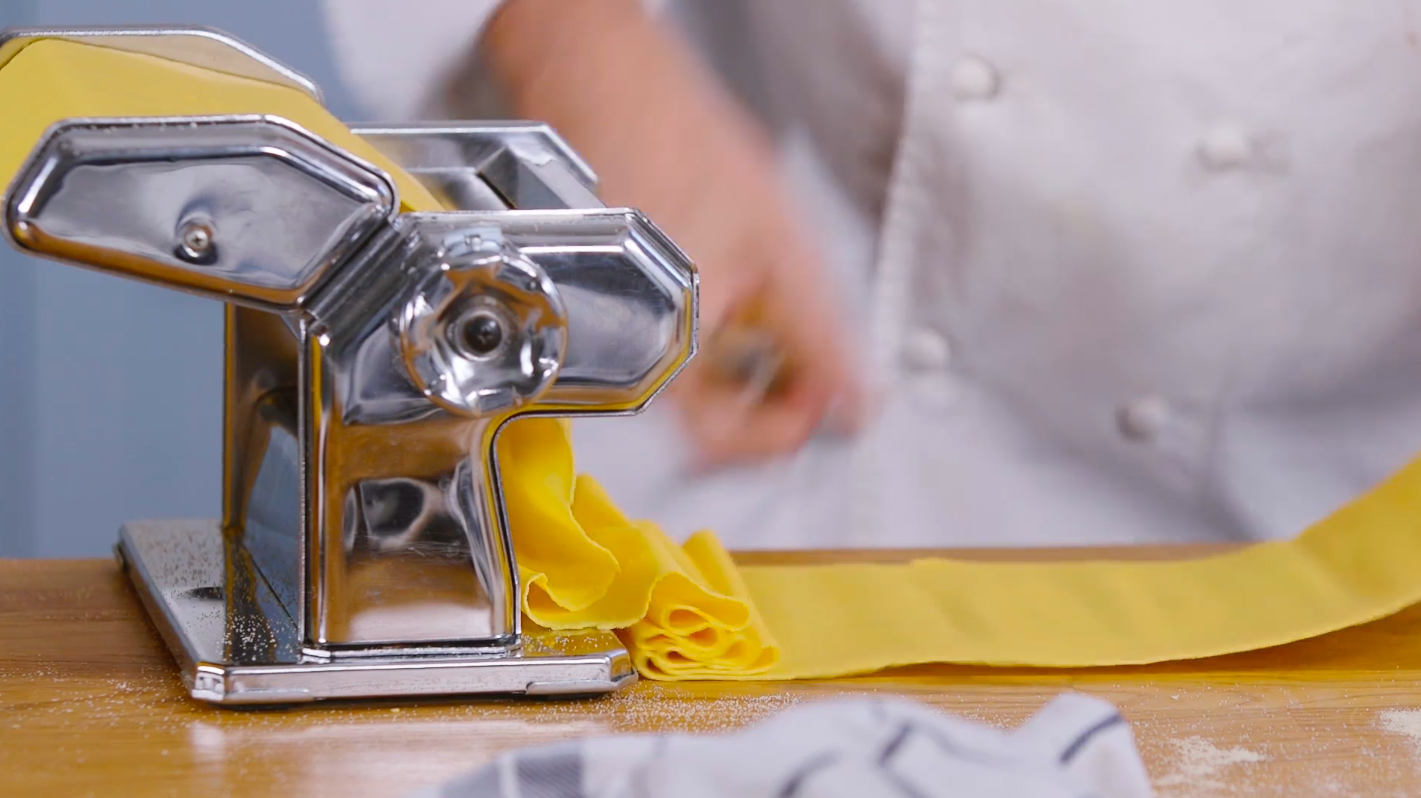
Next, begin to work the pasta through the thinner settings, reducing notch by notch each time you feed the dough through. You don’t need to fold the pasta now, but if it gets too long, cut it in half so it’s easier to work with. After this, it will be silky and golden and you should be able to see your hand through the dough.
Step 6
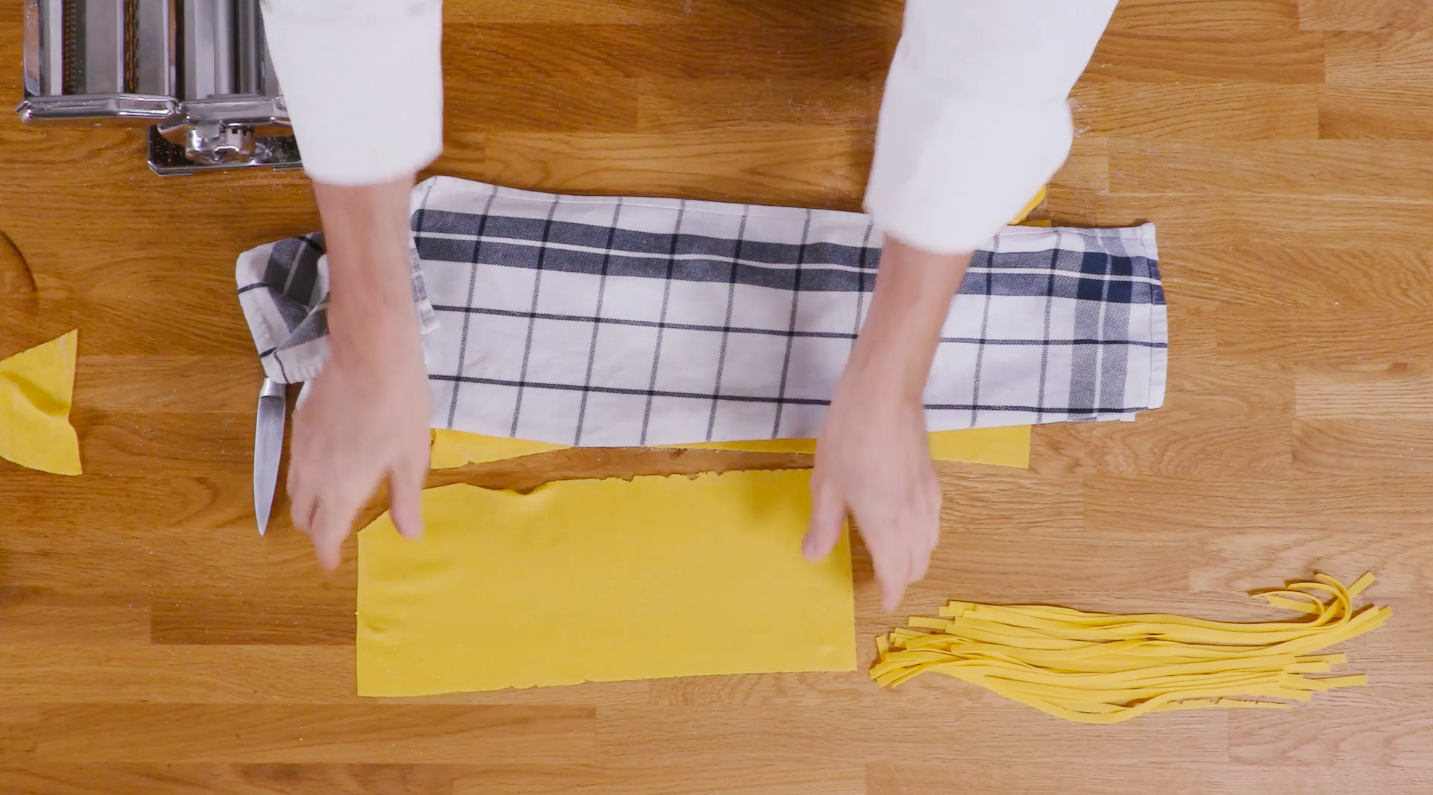
Cut the dough into long rectangles. Lay on top of each other, sprinkling a little semolina flour in between each layer so they don’t stick together.
Step 7
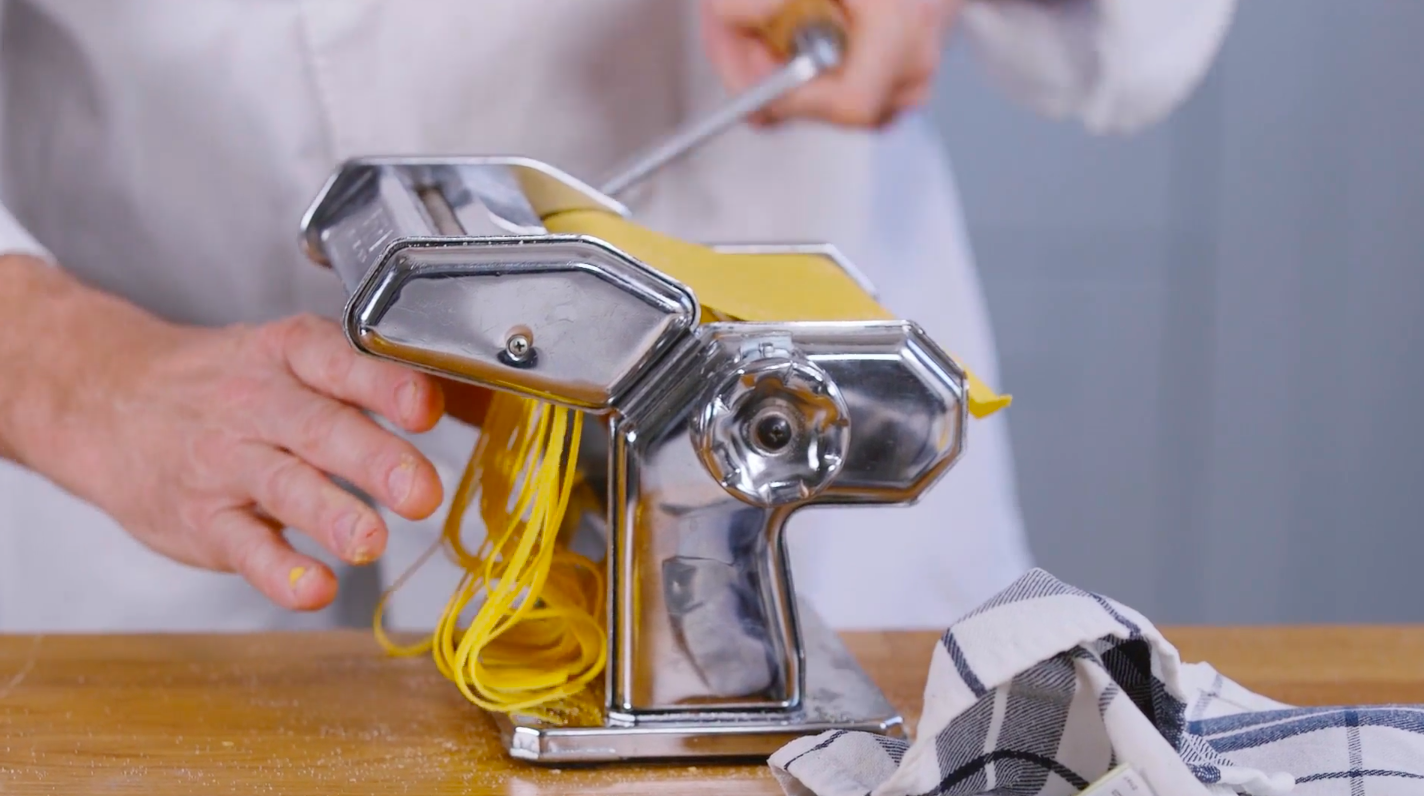
If you’re making tagliatelle or tagliarini (the fresh version of spaghetti) – like Theo shows in the video recipe – set the pasta machine to the right cutting setting and feed each pasta layer through the machine. You can also do this by hand by laying the pasta layers flat, dusting with semolina flour, then slicing into strands.
Step 8
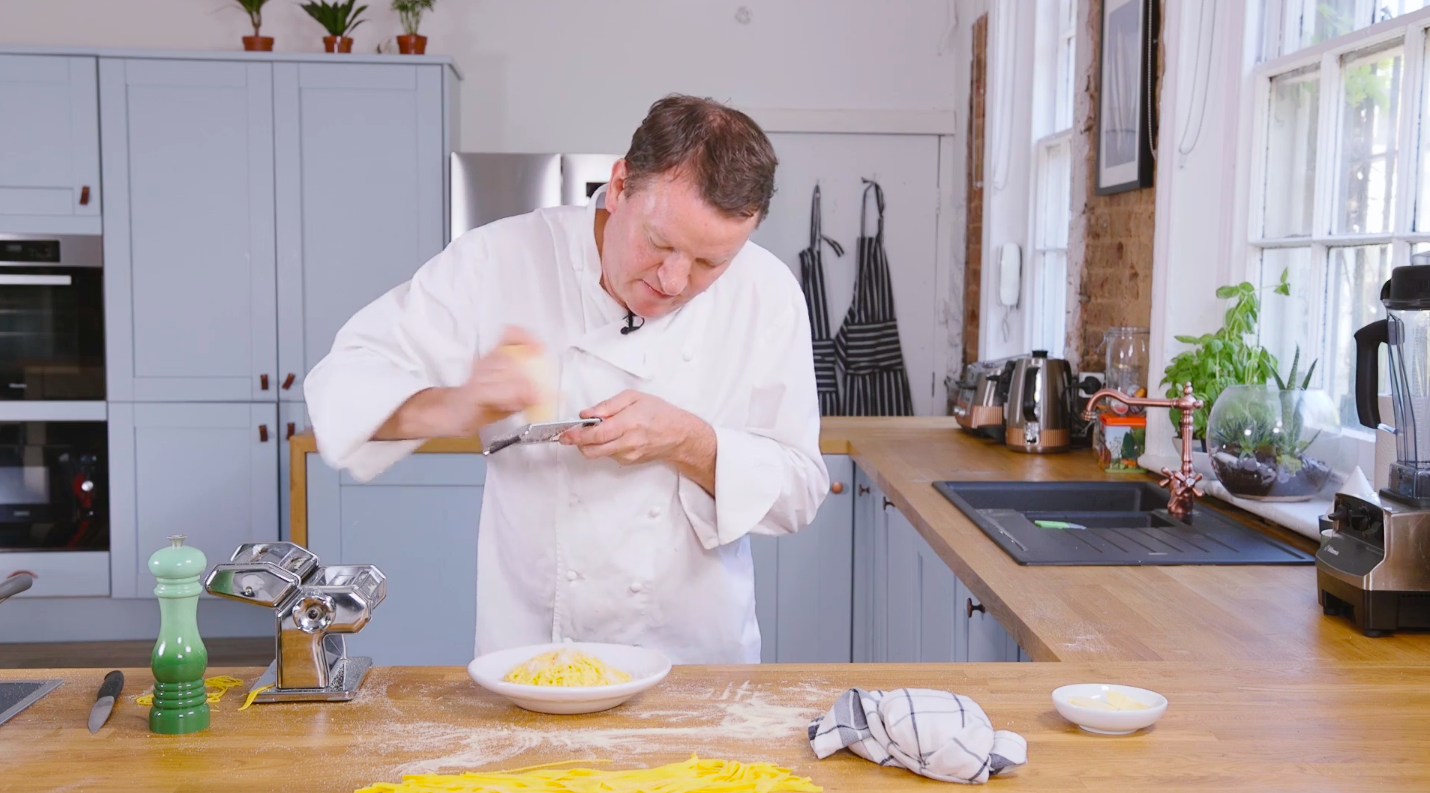
Cook the fresh pasta in boiling, salted water for 2-3 minutes. Serve with butter, black pepper and Parmesan, or add it to a sauce of your choice and mix it in so until the sauce emulsifies.
Theo finishes his dish with his choice of Parmesan, which can be grated before you start the recipe, along with truffle, if you like.
FAQs about making fresh pasta
How do I make pasta without a pasta machine?
If you plan of making your own pasta on a regular basis, a pasta machine is a worthwhile investment. Otherwise, just use a rolling pin and follow these steps:
- Divide the pasta dough into 3 equal pieces – this makes the process more manageable.
- On a lightly floured surface, roll the dough into a rectangle. The size here depends on the quantity you’re rolling but, as a guide, go for 30cm by 15cm.
- Roll the dough to the thickness of a £1 coin and then fold in half and roll again. Repeat this several times until you have a smooth sheet to work with.
- The thickness of the final roll will depend on what you’re planning to make. For something like pappardelle or tagliatelle, roll the sheet quite thinly – around 2mm; Italians say that you should be able to read your newspaper through it. The sheet can become quite long as you roll, so cut into small sheets if necessary.
- Once you’ve achieved the desired thickness (in this case, 2mm or thereabouts) cut in sheets of around 20-25cm in length. You can use these for lasagne, or loosely roll them up and cut into strips – 2cm wide for pappardelle, 1cm for tagliatelle, and around 2.5 mm for linguini.
Do you have tips for making fresh pasta from scratch?
Follow these handy nuggets of advice and the pasta-making process should be stress-free.
- Place a slightly damp cloth or tea towel over pasta dough until you’re ready to work with it, or between cooking stages. Otherwise, the dough can dry out.
- Put a light dusting of flour on the work surface when working dough. Don’t overdo it though, as too much can dry out the pasta.
- When rolling the dough through a machine, don't force it. Let the machine do the work and take your time.
- Run the dough through each setting until you reach the desired thickness. Don't speed things up by going from the thickest setting to the thinnest too quickly, as this will tear the dough.
- When you make shapes, the sky is the limit. You can let your creativity run wild and experiment with different forms or follow our suggestions, below.
How should I cook fresh pasta?
When it comes to cooking, fresh pasta is a different beast to dry, packaged pasta. Commercially-made dried pasta usually takes 8-12 minutes to cook (longer if it’s wholemeal), while fresh pasta only requires around 2-4 minutes. And if you make your own pasta and dry it at home, it still won’t take as long as shop-bought dried pasta.
To cook, bring a large pan of salted water to a rolling boil. Add the pasta carefully – fresh pasta, for example, needs a gentle touch and should be added in small batches.
Depending on the type of pasta you’re using, cook for 2-4 mins if it’s fresh (until the pasta floats to the top), or according to the packet’s instructions if it’s dry.
Drain, then serve immediately. See our handy guide for more advice on how to cook pasta.
What’s the best way to store fresh pasta?
Fresh pasta dough wrapped snugly in cling film or an airtight bag, will last in the fridge for up to 3 days, and it can be frozen for up to 2 months. Dust the dough in a little flour before chilling, and allow it to come up to room temperature before rolling or shaping – this makes it much easier to work with.
You can also dry out fresh pasta dough that’s been shaped so it can be stored for longer. If you’re cutting the pasta into strips, drape each one over a pasta drying rack until dry and slightly brittle. Don’t have a pasta drying rack? You’re not the only one – drape the strips over the back of a chair, clothes horse, or on coat hangers.
If you’re making shapes, lay the shapes, not touching, on a tray lined with baking paper. Store in a warm dry place for 24 hours before placing in an airtight container and storing in a cool, dark place. Egg pasta lasts for up to 3 months; egg-free for up to 6 months.
How do I make homemade fusilli al ferretto?
This curly shape is one most of us will recognise. It’s not identical to the mass-produced fusilli you find in supermarkets, but it’s similar. The great thing about this shape is that you don't have to roll the dough in a machine, so it's a good one for beginners.
1. Take some dough and roll it into a long strip on the worktop; around the thickness pencil or a chopstick.
2. Cut into lengths of around 5cm and roll around a metal rod “ferretto” starting from the one end and rolling to the other. You can also use a kebab stick or wooden skewer.
3. Gently slide the pasta shape off the device. Repeat.
How do I make homemade orecchiette?
Orecchiette, meaning “little ears”, is possibly the cutest shape in the pasta world (with the exception of stelline, or “little stars”. These little curved discs actually have a practical use – they’re ideal for holding sauce. And you don’t need a pasta machine to make them.
1. Take the dough and roll it into a long thin sausage shape.
2. Cut bite-size pieces of the dough off the end and, using a butter knife drag the blade over the pasta which will stretch the dough.
3. Once stretched, overturn the pasta onto your thumb to create little cups, or “ears”.
How do I make homemade farfalle?
Farfalle is one of the most common pasta shapes. In the UK, we refer to farfalle as “bowties”, though the word translates as “butterflies” in Italian.
1. To get the jagged edge synonymous with farfalle you will need a fluted pasta wheel.
2. Using a pasta machine, roll the dough to 2mm, then cut it into 2cm-wide strips.
3. Next, using the fluted pasta wheel, cut each strip into 4cm rectangles.
4. To fold, pick up the rectangle and fold it in half, along the length.
5. Pinch the centre at the base and then fold the edges back in the opposite direction and pinch again. Still confused? Watch this video with Jamie Oliver’s long-time friend, Gennaro Contaldo.
How do I make homemade tortellini?
Tortellini is a stuffed, ring-shaped pasta from Bologna and Modena. Traditionally packed with a mixture of pork, egg and cheese and served in a broth, these days you’re likely to find tortellini stuffed with a variety of creative fillings and served in a broth or sauce.
1. Using a pasta machine, roll the dough to 2mm then cut it into 5cm squares. Tortellini shouldn't be too big, and the key here is not to overfill, otherwise the filling will burst out.
2. Place a small penny-sized amount of filling in the centre of each square. Pick up and form a triangle by pinching the top and bottom corners together and securing around the edges. You can use a dab of water here to help the edges stick.
3. Take the longest edge of the triangle (the edge you didn't pinch together) and work from one corner, wrap it around your index finger, pinching and securing it with the other corner. This may take a few attempts, but once you have the hang of it you’ll be flying. If you’re still not sure, here's Gennaro to shows us how again (this time on a boat with Jamie).
The best pasta making tools
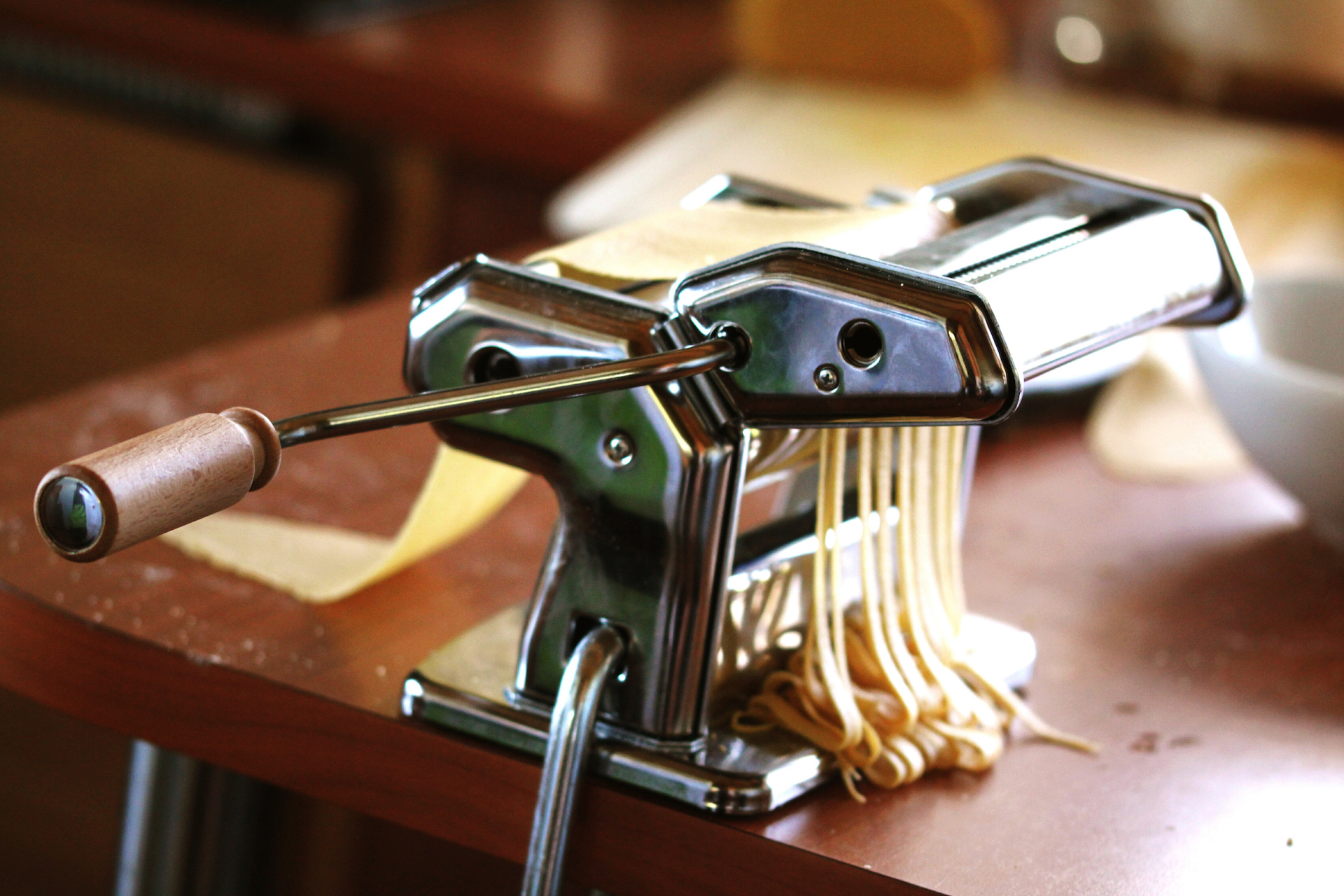
If you want to make your life a little easier by investing in some equipment, or you just want to experiment with some new gadgets, we've rounded up our favourite pasta tools just for you...







